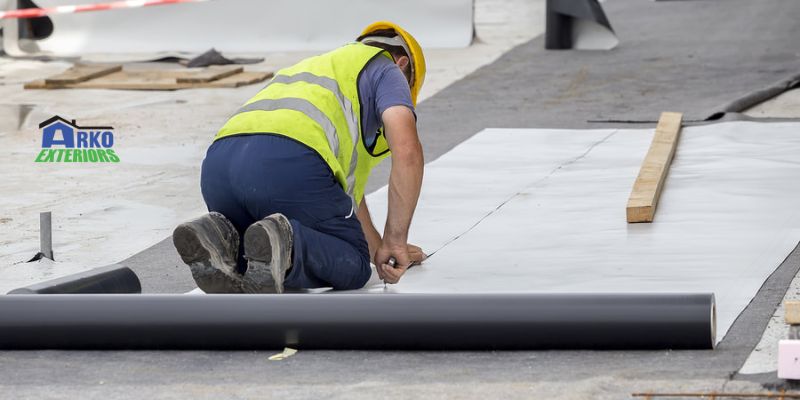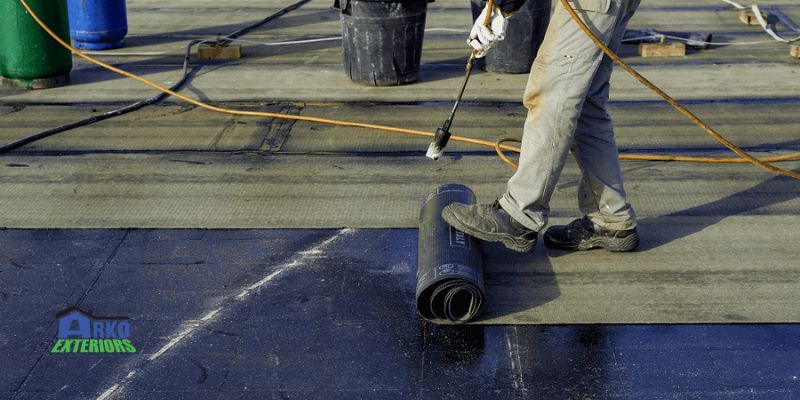A flat roof, which can be spotted on different residential, commercial, and industrial buildings is contemporary, reliable, and practical. Choose flat roofing to take on a modern, streamlined design without all the hassle. It offers easier maintenance and upkeep along with quicker and less expensive installation.
Indicators Your Flat Roof Needs to Be Replaced
Some signs point to the need for a roof replacement. If you notice these indicators, you must consider replacing your flat roof:
- Leakages: If your flat roof is experiencing persistent or extensive leaks, that is a sign that it is time to consider replacing it. While minor leaks can often be repaired, widespread water damage suggests a deeper issue. This could be due to faulty installation, significant impact damage, or simply the end of the roof’s lifespan.
- Sagging, pooling, and flooding: If minor water pooling occurs on your roof regularly, it may be possible to fix the problem by repairing the existing roofing system. However, if water has been pooling, flooding, or sagging for an extended period, it may have caused additional damage, such as rot or leaks. In these situations, consider replacing the entire roof.
- Stretching, blistering, cracking, splitting, and punctures: Over time, your flat roof may start to show signs of wear and tear due to exposure to the elements. This can include splitting, cracking, blistering, or even stretching without returning to its original shape. These damages can pose a serious threat to the structural integrity of your roof.
Flat Roof Replacement Methods

The specific replacement process depends on the type of roofing material being used. To give you a better understanding of what is involved in roof replacement, here is what is involved for each type:
1. GRP
Removing GRP fiberglass roofing can be done using a tool like a circular saw to cut through the material. It is essential to work across the roof in sections, which may lengthen the overall process.
Installing a GRP roof requires dry and mild weather conditions. Temperatures below 5 degrees Celsius are not recommended as they can affect the proper curing of the resin and topcoat. If rain occurs during the installation, it is crucial to stop the project and cover the roof until the weather improves.
Additionally, the installation procedure involves laying OSB3 decking boards, followed by the application of a layer of catalyzed resin. Next, a layer of fiberglass matting is placed on top, followed by another layer of catalyzed resin to complete the system. Once cured, a fire-retardant topcoat resin is applied to achieve the final finish.
2. EPDM

To begin the removal of EPDM from your roof, start by sectioning the membrane into pieces and carefully lifting each rubber section off the surface. It is advised to undergo this process in smaller sections, especially for larger roofs, as it can be quite time-consuming.
For optimal installation of an EPDM roofing system, you must lay it on a timber deck, ideally constructed from exterior-grade ply or OSB3. Before installation, thorough cleaning and preparation of the roof surface are important because EPDM does not adhere to wet surfaces easily.
In the typical application of EPDM, the material is unrolled and positioned across the entire flat roof surface. Also, it is smoothed out using a broom or a similar tool to ensure a completely even finish. Trimming may be necessary to remove excess EPDM rubber and get a seamless fit for your roof.
Additionally, to secure the EPDM membrane, a water-based adhesive is applied to the decking, with half of the membrane pulled back for easy application. For edges and intricate sections of the roof, a stronger contact adhesive is used to ensure secure fixation of the EPDM membrane in corners and more complex areas of the roof space.
3. Self-adhesive felt
Removing self-adhesive felt is a straightforward process. Start by lifting the felt’s edges and carefully tearing it away, disposing of it piece by piece. Protective gear, such as goggles and gloves, is essential during this task.
Self-adhesive roofing felt is a popular choice due to its ease of installation, particularly for flat roofs. Begin by laying the initial underlay felt on the wooden decking. When installing the second layer of underlay felt, ensure it does not overlap with the first layer.
After installing gutter drips, apply the top layer of felt using the same method as the second layer. Peel off the release film and then self-bond it directly to the surface.
4. Torch-on felt
To remove the torch-on felt, use a utility knife with a hook blade to carefully cut through the top layer of the felt. Next, use a roofer’s tear-off shovel or pitchfork to lift the felt from underneath and roll it back into sections.
To install torch-on felt, first apply three layers of modified bitumen to the roof surface. Then, use a blowtorch to heat the underside of the felt and melt it onto the bitumen. Be sure to roll out the felt evenly and press down firmly to ensure a strong bond.
Why You Should Hire An Expert Roofing Contractor For Your Flat Roof Replacement
Since replacing your roof is a major investment, choosing a qualified contractor should be done carefully. The success of the project is significantly influenced by the contractor’s reputation and level of experience. You must choose a contractor with substantial experience in flat roof replacement systems to guarantee a strong and long-lasting roof.
Furthermore, it is advisable to choose a roofing company that specializes in flat roof replacements for both residential and commercial buildings. Their specialization shows that they are adept at managing the particular difficulties that come with flat roofs. Make sure the cost of the work is within your means by carefully comparing the contractor’s rates to your allocated spending.
Conclusion
The replacement of a flat roof is a big project that needs to be carefully planned. Do not forget to select a licensed contractor, get the required permits, and plan the project for a time of year that works best for you. Your new flat roof will increase the value of your house and offer years of protection with the right upkeep.

